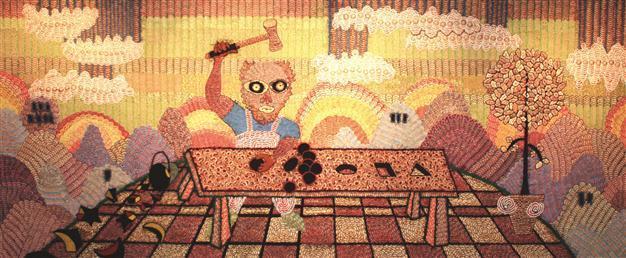People and Turkish history revealed at exhibition
ISTANBUL - Hürriyet Daily News

Charlie Swan uses pencil shavings to create his works. His works focus on the characters and incidents. His work ‘Kaan of Tophane’ inspired from Tophane attack in 2010.
Charlie Swan makes his artwork with a unique technique he calls paving, using pencil shavings. His current exhibition at the Studio 9 art gallery in Nişantaşı showcases his flamboyant works.
Swan likes to investigate people’s backgrounds. That’s why his show mainly focuses on “characters” which may act like the characters in a novel. His pieces, depicting the history of Turks, Göktürks, nomadic tribes and modern day phenomena in Istanbul, make the viewer wonder about paganism, polytheism, Islam and monotheism.
“The technique I use has been my main communication tool for many years,” said Swan, noting that before creating his works he first researches the people and events he wants to focus on.
“I spend three or four hours on library and internet research,” he said, adding that his studio, located in the Tophane district, also gives him the chance to discover more about Turkey. “The locals in the area are ethnically diverse; I focus on characters coming directly from Anatolia, the Black Sea and regions like that. So I also focus on their past stories.”

Swan illustrates early Turkish history in his work Moot Hill Bumin Qaghan, which depicts the founder of the Turkic Khaganate, Qaghan. It features the crescent and Turkish symbols and shapes. With this piece, Swan may refer to Turkish history, but he also looks at his own ancestral past. “That’s why this piece is also called Moot Hill. Throughout Britain and Scotland there are different hills where elders would come to take legal decisions and important decisions.” In the piece, the subject stands on a hill and there is a checkerboard effect that may refer to decision making, significant developments and historical facts. “In fact, it is about what ‘historical fact’ means. This is a cross between a puzzle and a story,” said Swan.
Technically, Swan uses about 15,000 to 20,000 pencils for a 340 cm by 140 cm piece. “It changes according to the angle and depth of the blade. The intensity of the color and material differ depending on the different woods of the pencils.”
According to Swan, the pencil is a basic material, to which all humans have been exposed: “Despite computers, sales of pencils are higher than ever, due to emerging market economies.” At a very interesting time of emerging markets, the pencil is perhaps equally – or even more - relevant than it has ever been, he said.
Scenes from Tophane
Swan’s works do not only reflect ancient history, they also suggest a vision and approach to the contemporary history of Istanbul and Turkey. Swan likes to reflect the environment he is living in. “Kaan of Tophane” depicts his friend Kaan, who was injured during the attack on a Tophane art gallery, which took place in 2010.
With its unique locals and architectural character, Tophane continues to inspire Swan. In one of his works, “Where is Heinz Kloss,” Swan shows Heinz Kloss, a German linguist who was an internationally recognized authority on linguistic minorities. Kloss is depicted as an old man passing through a Tophane church. k HDN


